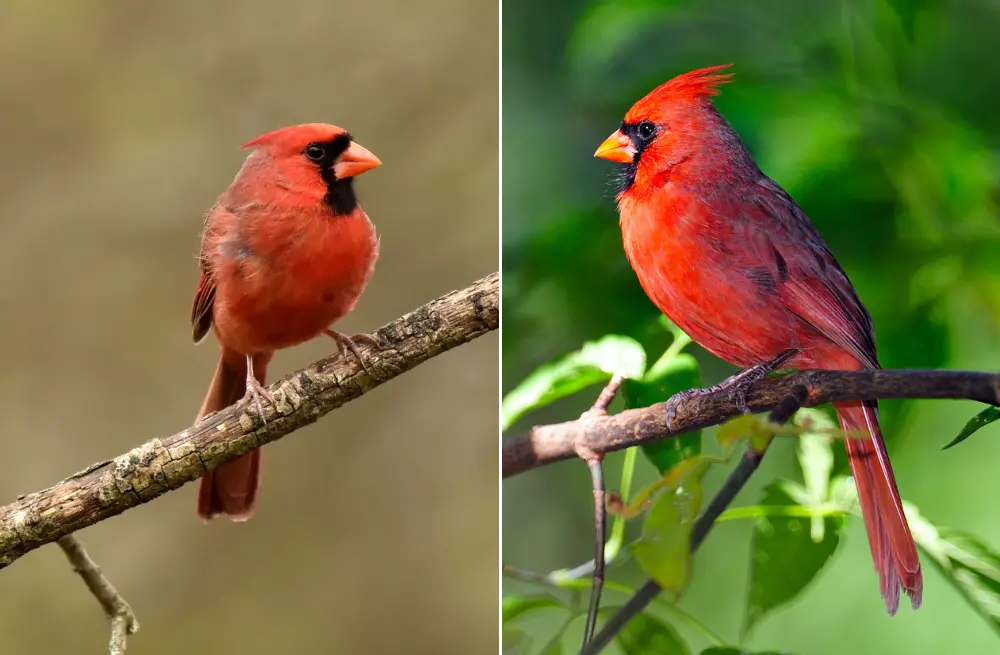32 Stunning Birds with Red Heads & Where to see Them
The avian world is a realm of diversity and beauty, and among its many wonders are birds with striking red heads. These feathered creatures, with their vibrant plumage, capture our attention and leave us in awe.
In this article, we’ll explore a list of 32 bird species known for their distinctive red-headed or red-capped appearances. These remarkable avian creatures are scattered across the globe, showcasing a variety of stunning red hues on their heads.
You’ll find information and images to aid in identifying these captivating birds, making it easier for bird enthusiasts and nature lovers to spot and appreciate them in the wild.
Plus, we’ll sprinkle in some fun facts about red-headed birds to pique your curiosity along the way.
32 bird species with red heads
01. Northern Cardinal (Cardinalis cardinalis)
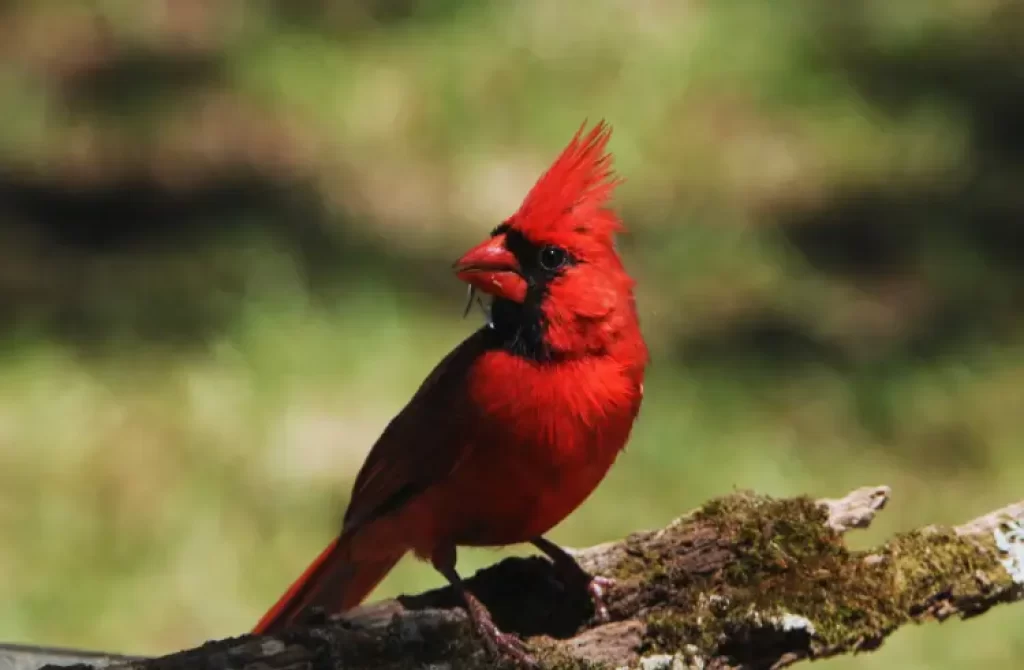
The Northern Cardinal (Cardinalis cardinalis) is a cherished symbol of North America, known for its stunning red plumage that graces gardens, woodlands, and urban areas alike.
Males flaunt vibrant red feathers, while females exhibit a subtler charm. These birds are frequent visitors to bird feeders, adding a touch of elegance to any backyard.
Apart from their visual appeal, Northern Cardinals are famous for their sweet and melodious songs, which echo through treetops. They are year-round companions, resilient in different climates and adaptable to urban life.
🎶 Year-round Singers: Northern Cardinals are known for their beautiful songs, and they sing throughout the year, even in winter. Their melodious tunes are a bright spot in cold months.
With cultural significance and positive symbolism, encountering a Northern Cardinal is a delightful experience that brings color, song, and a touch of magic to our surroundings.
02. Acorn Woodpecker (Melanerpes formicivorus)
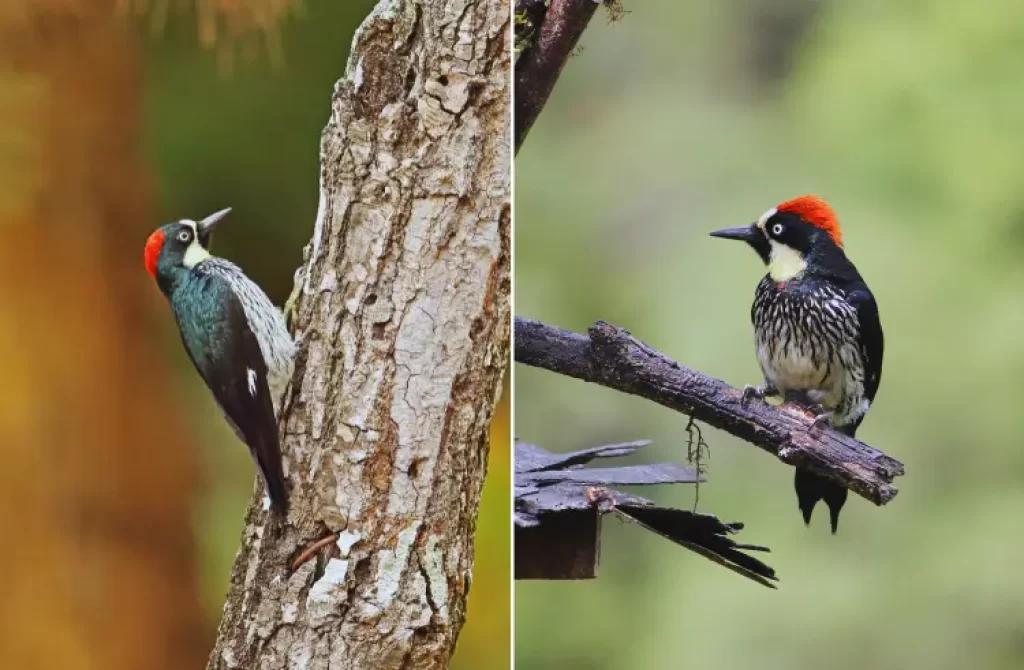
The Acorn Woodpecker (Melanerpes formicivorus) is a distinctive and charismatic bird known for its striking appearance, unique behavior, and its impressive dedication to acorn storage.
Acorn Woodpeckers are easily recognizable by their vibrant features. They sport a combination of black and white plumage with a bold red cap on their heads. This striking coloration makes them stand out in their forested habitats.
These woodpeckers inhabit a range that extends from the western United States down to Central America. They thrive in a variety of environments, including oak woodlands, pine forests, and even urban areas with mature trees.
One of the most fascinating aspects of Acorn Woodpecker behavior is their acorn storage strategy. They create granaries, often in the form of holes in trees or wooden structures, to store thousands of acorns. These communal food caches are meticulously organized and maintained by family groups of woodpeckers.
Acorn Woodpeckers are highly social birds and often live in large, cooperative family groups. These groups are led by a dominant breeding pair, and other group members help with tasks like nest-building, food storage, and chick-rearing.
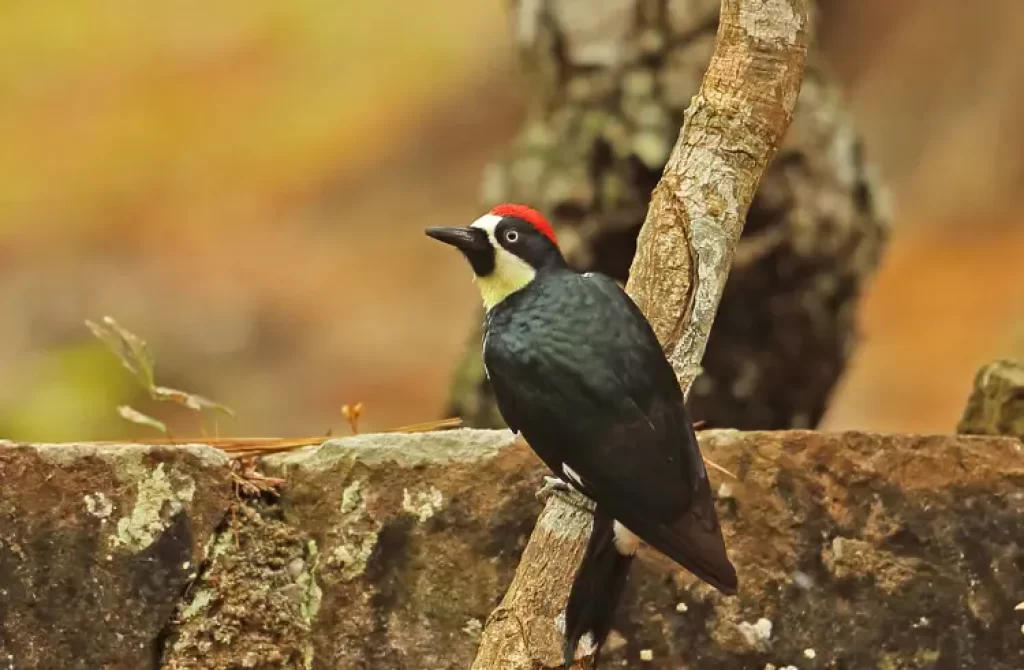
As their name suggests, acorns are a primary component of their diet. However, they also feed on insects, fruits, and tree sap. Their versatile diet makes them adaptable to seasonal variations in food availability.
These woodpeckers are known for their distinctive vocalizations, which include a variety of calls, rattles, and drumming sounds. Their calls are used for communication within family groups and to establish territory.
Fun fact: 🦜 These woodpeckers are highly social and often live in large family groups. Cooperative breeding and sharing of granaries are common practices, making them a close-knit bunch.
The Acorn Woodpecker is generally considered a species of least concern in terms of conservation. Their adaptability to various habitats and their ability to thrive in suburban areas have contributed to their stable populations.
Observing the Acorn Woodpecker’s intricate social structures and their industrious acorn storage methods is a testament to the fascinating world of avian behavior and adaptation.
03. Red-headed Pileated Finch
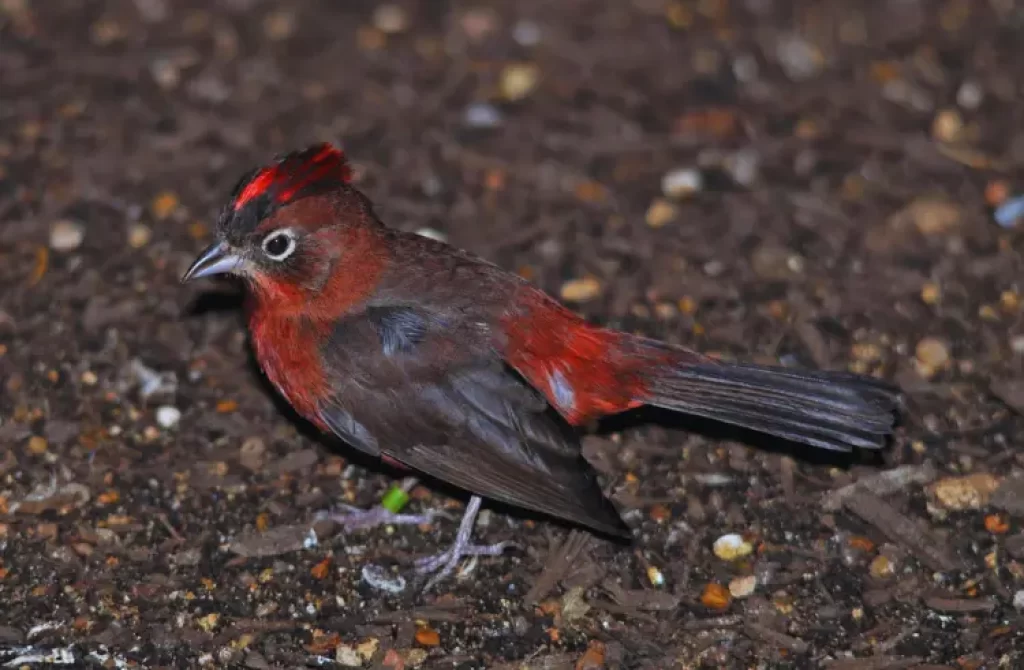
The Red-headed Pileated Finch (Coryphospingus cucullatus) is a small, vibrantly colored bird found in parts of South America, particularly in Brazil and Argentina. This finch gets its name from the striking red plumage on its head and neck, which makes it instantly recognizable.
The Red-headed Pileated Finch is primarily brownish-gray with a fiery red crown, face, and throat. Its overall appearance is complemented by a slender, pointed beak and a slightly curved tail.
These finches are commonly found in open woodlands, savannas, and grassy areas, often near water sources like rivers and streams.
Their diet mainly consists of seeds, fruits, and insects. They forage for food on the ground and in low vegetation.
Red-headed Pileated Finches are social birds, often seen in small flocks. They are known for their melodious songs and active feeding behavior.
While their populations seem stable, habitat loss due to deforestation is a potential threat to their long-term survival.
Fun fact: 🌅 Early Birds: These finches are not just early risers; they’re the ultimate sunrise singers! Imagine waking up to their melodious tunes at the crack of dawn—it’s like having a natural alarm clock.
Male Red-headed Pileated Finches have more vibrant red plumage compared to females, making them stand out during courtship displays.
Observing these charming finches in their natural habitat can be a rewarding experience for birdwatchers and nature enthusiasts.
04. American Robin (Turdus migratorius)
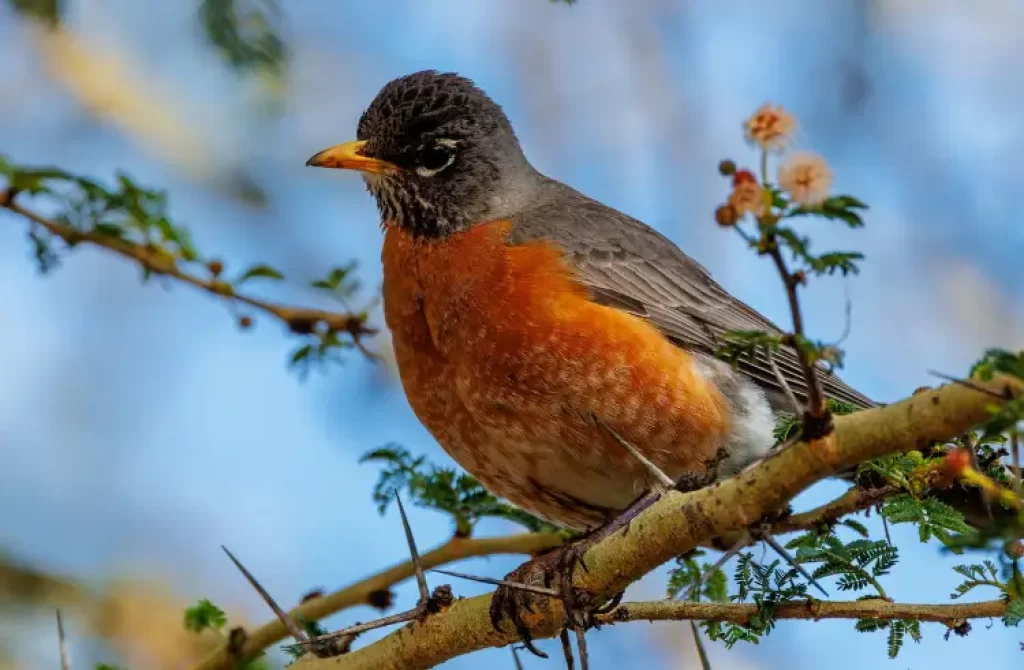
The American Robin, recognized by its distinctive rusty-red breast, is a frequent visitor to gardens and parks, often signifying the arrival of spring in many regions.
It’s a medium-sized songbird with a length of about 10 inches (25 cm) and a wingspan of approximately 17 inches (43 cm). While its name suggests a connection to Europe, it’s a purely North American species.
This bird plays a vital role in spreading seeds and maintaining insect populations, making it an essential contributor to the ecosystem. Its cheerful song and vibrant plumage make the American Robin a beloved symbol of renewal and warmer seasons.
05. Red-crested Pochard (Netta rufina)
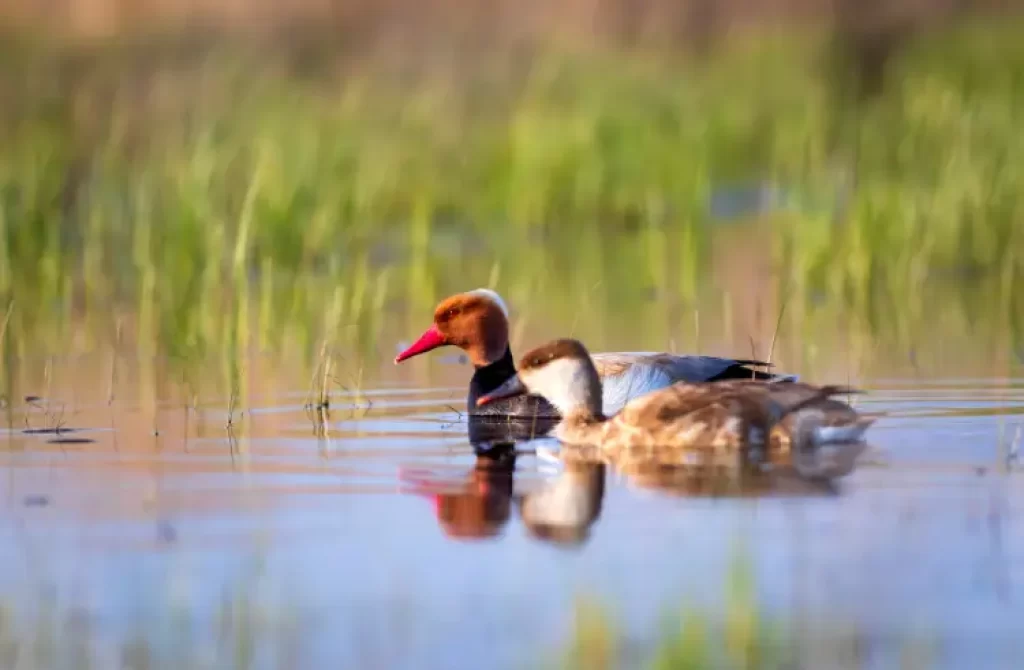
The Red-crested Pochard, a diving duck, is known for its eye-catching appearance, featuring a brilliant red head and a contrasting white face.
This striking bird is commonly found in the wetlands of Europe and Asia. It’s a medium-sized duck, with males typically measuring around 19 inches (48 cm) in length.
During breeding season, the male Red-crested Pochard sports its vibrant red crest, making it a standout in its habitat. These ducks are known for their unique and attractive plumage, adding a burst of color to the serene wetland landscapes they call home.
06. Red-headed Woodpecker (Melanerpes erythrocephalus)
The Red-headed Woodpecker (Melanerpes erythrocephalus) is a visually arresting bird species native to North America. Renowned for its bold, colorful plumage and unique behavior, it’s a true gem of the woodpecker family.
As the name suggests, Red-headed Woodpeckers sport a vibrant crimson head, a stark contrast to their snowy white underparts and jet-black wings and tail. This striking combination of colors makes them easily identifiable.
These woodpeckers are found across much of North America, primarily in woodlands, open forests, and wetlands. They are highly adaptable and can thrive in a variety of habitats, including suburban areas.
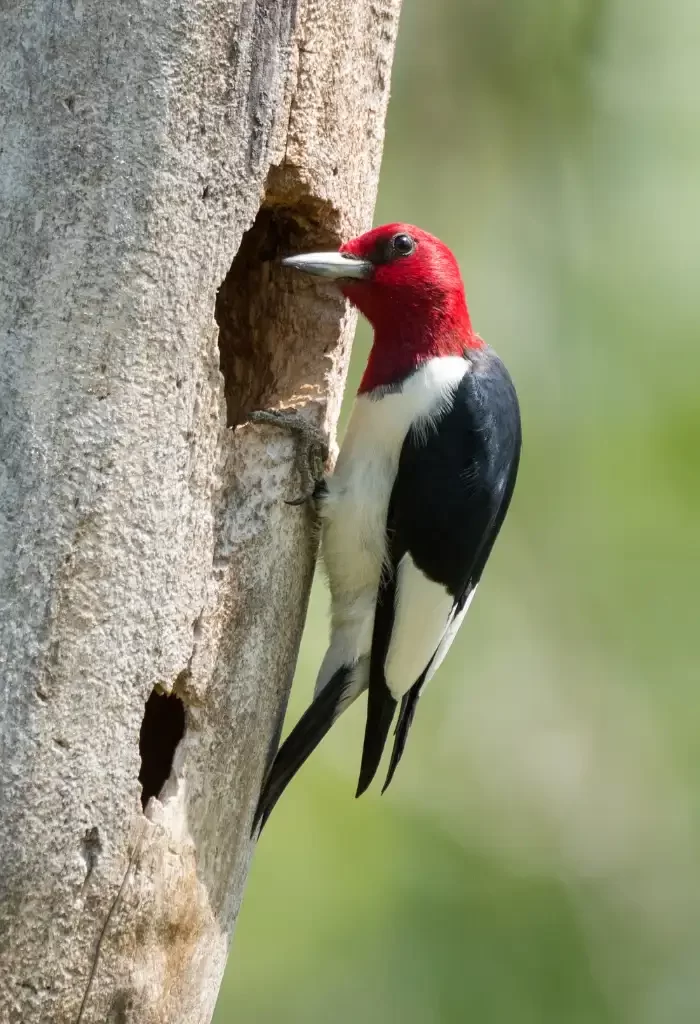
One of the most distinctive behaviors of Red-headed Woodpeckers is their habit of catching insects in mid-air. They are known for their aerial acrobatics, making them skilled hunters. They also feed on fruits, nuts, and occasionally store food in tree crevices or the ground.
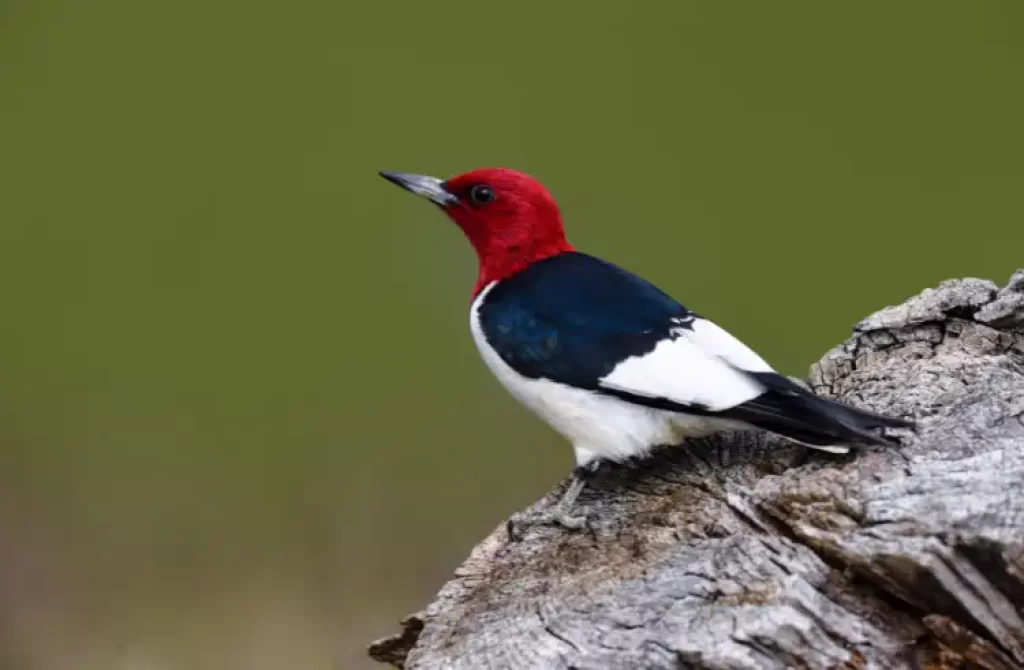
Their calls include a variety of churrs and rattles, but they are not as vocally prominent as some other woodpecker species.
🤳 Fun fact: Red-headed Woodpeckers are known to use their reflections in windows or car mirrors to communicate with other birds. They may perceive their reflection as a rival and engage in territorial displays. Selfies, woodpecker-style!
Spotting a Red-headed Woodpecker is a memorable experience for bird enthusiasts, and their presence in woodlands and open spaces adds a touch of vibrant beauty to the North American landscape.
07. Pileated Woodpecker (Dryocopus pileatus)
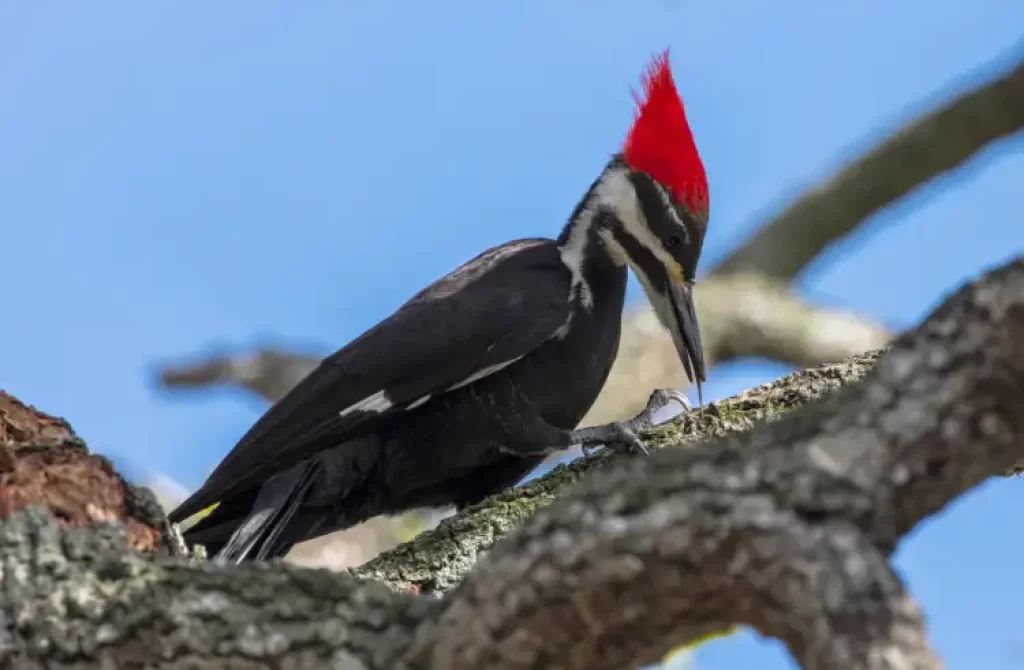
The Pileated Woodpecker is a magnificent bird known for its striking red crest, and it is commonly found in mature forests throughout North America.
This impressive woodpecker is one of the largest in North America, measuring around 16 to 19 inches (40 to 49 cm) in length. Its distinctive red crest adorns its head, making it easily recognizable among the trees.
With its powerful beak, the Pileated Woodpecker excavates large holes in search of insects and creates distinctive rectangular-shaped holes in trees. Observing this remarkable bird in its natural habitat is a thrilling experience for birdwatchers and nature enthusiasts alike.
08. Scarlet Tanager (Piranga olivacea)

The Scarlet Tanager is a jewel of North American forests, known for the brilliant red plumage that adorns its body and head. This bird’s striking appearance features vibrant red that contrasts with its black wings, creating a stunning visual spectacle.
The male Scarlet Tanager stands out among the lush greenery, making it a favorite sight for bird enthusiasts. These birds primarily inhabit deciduous woodlands and are often spotted foraging for insects among the leaves.
Observing a Scarlet Tanager in its natural habitat is a rewarding experience, as it adds a vibrant splash of color to the forest canopy.
09. Red-breasted Merganser (Mergus serrator)
The Red-breasted Merganser is a captivating sea duck known for its distinctive red head, which sports a shaggy and eye-catching appearance. These birds are frequently observed in coastal areas, where they navigate both saltwater and freshwater environments with ease.
The contrast between their red head and grayish body is a defining feature of this species, making it easily recognizable.
With a penchant for diving and swimming, the Red-breasted Merganser is well-suited to its aquatic habitats and is a remarkable addition to the avian diversity found in coastal regions.
10. Red-vented Bulbul (Pycnonotus cafer)
The Red-vented Bulbul, native to South Asia, boasts an exquisite crimson feature that distinguishes it from other avian species—the striking red undertail coverts.
While its head isn’t predominantly red, these vibrant undertail coverts are a standout feature against its otherwise earth-toned plumage.
Found in a variety of habitats in South Asia, from gardens to forests, the Red-vented Bulbul brings a touch of color and charm to the landscapes it inhabits, making it a beloved sight among bird enthusiasts and nature lovers.
11. Red-masked Parakeet (Psittacara erythrogenys)
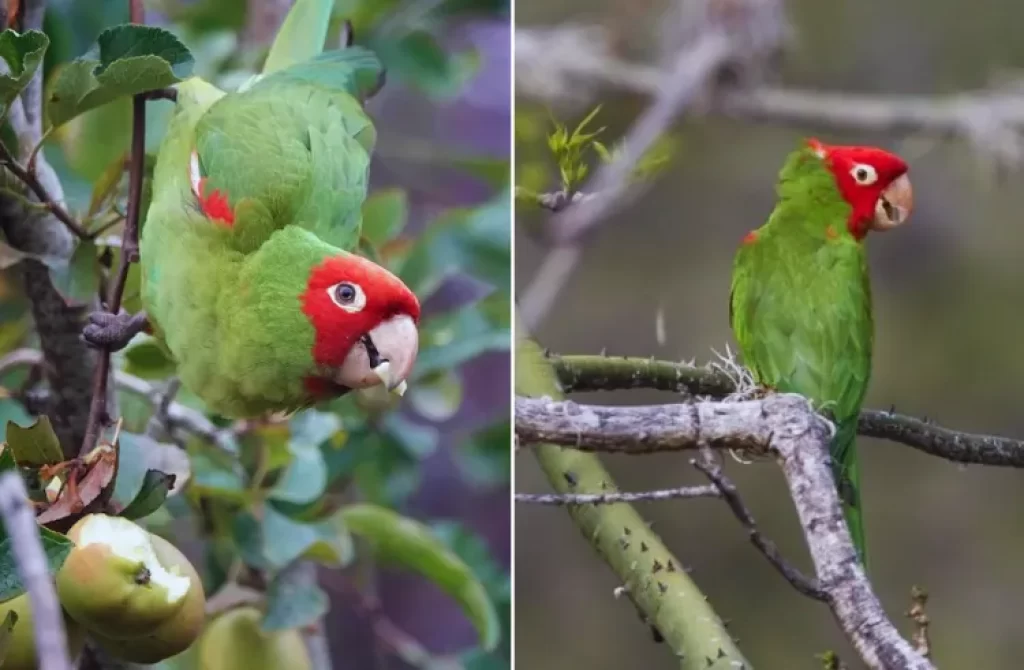
Native to South America, the Red-masked Parakeet (Psittacara erythrogenys) is a dazzling bird that contributes a splash of vivid red to the rainforests it calls home. With its bright red face and head, it stands out amidst the lush greenery.
These parakeets thrive in the subtropical climate of South America, where the combination of warmth and moisture creates an ideal habitat for them.
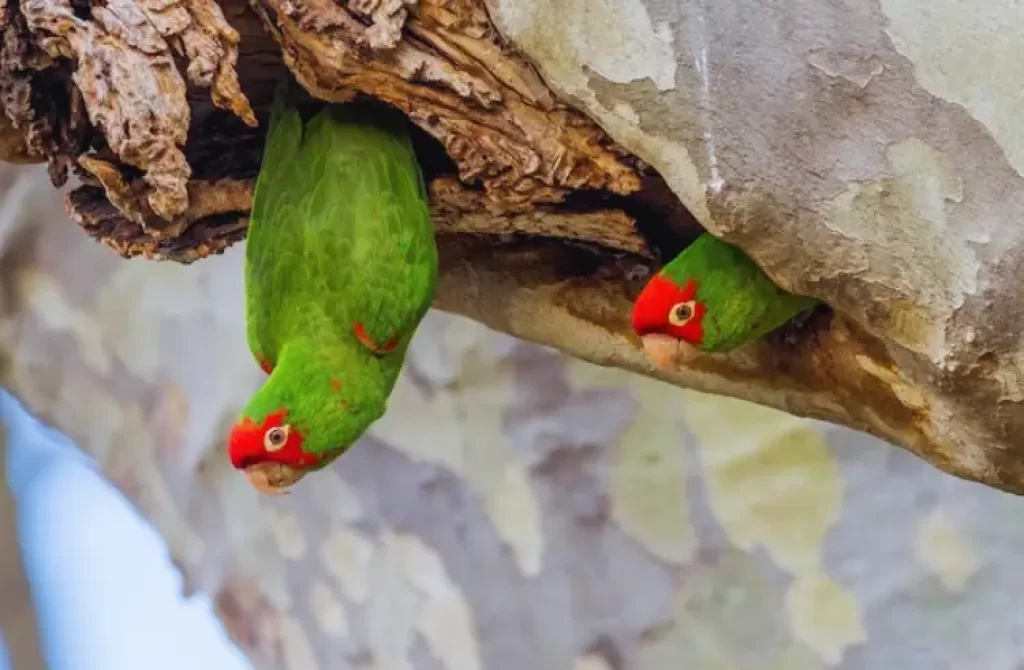
While they primarily inhabit rainforests, they are adaptable and can be found in various forested environments. These striking birds are a testament to the incredible biodiversity of the region.
Fun fact: 🤝 Parenting Team: Red-masked Parakeets are all about teamwork. Both parents share the responsibilities of incubating the eggs and caring for the chicks once they hatch.
12. Red-fronted Parrotlet (Touit costaricensis)
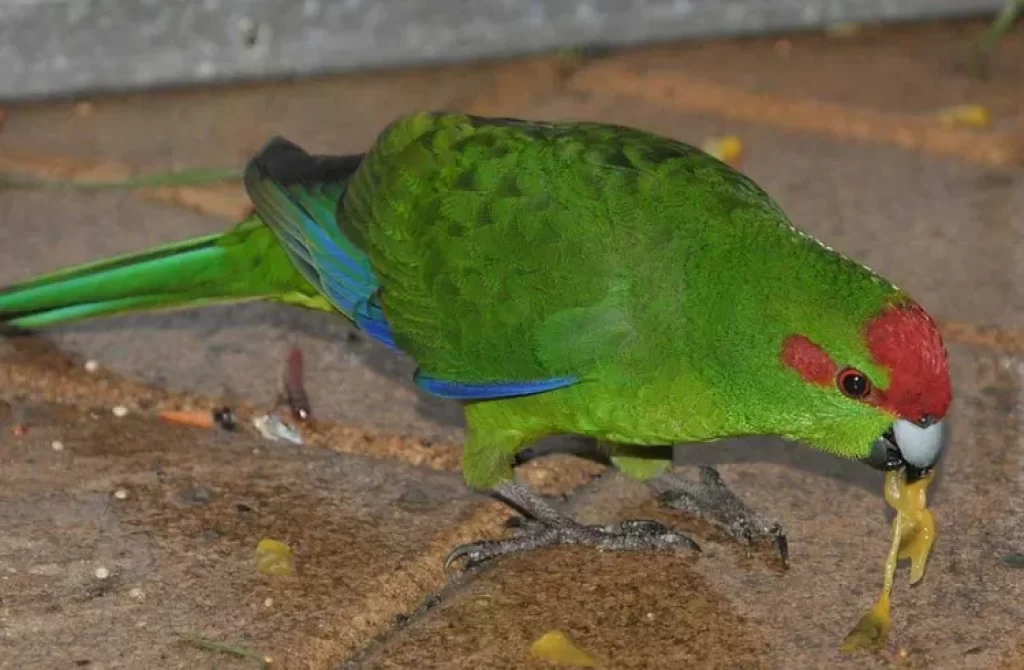
The Red-fronted Parrotlet (Touit costaricensis) is a captivating avian resident of the dense tropical forests that span Central and South America.
Its petite stature belies its stunning appearance, with a brilliant red patch adorning its forehead, adding a vibrant splash of color to the lush greenery of its habitat.
These parrotlets, with their endearing charm and striking plumage, serve as a testament to the breathtaking diversity of avian life in the region. Inhabiting the vibrant and biodiverse ecosystems of their native lands, they contribute to the symphony of colors and sounds that define the tropical paradise they call home.
Birdwatchers and nature enthusiasts are often enchanted by the Red-fronted Parrotlet’s presence, making it a beloved species in its native range.
13. Red-whiskered Bulbul (Pycnonotus jocosus)
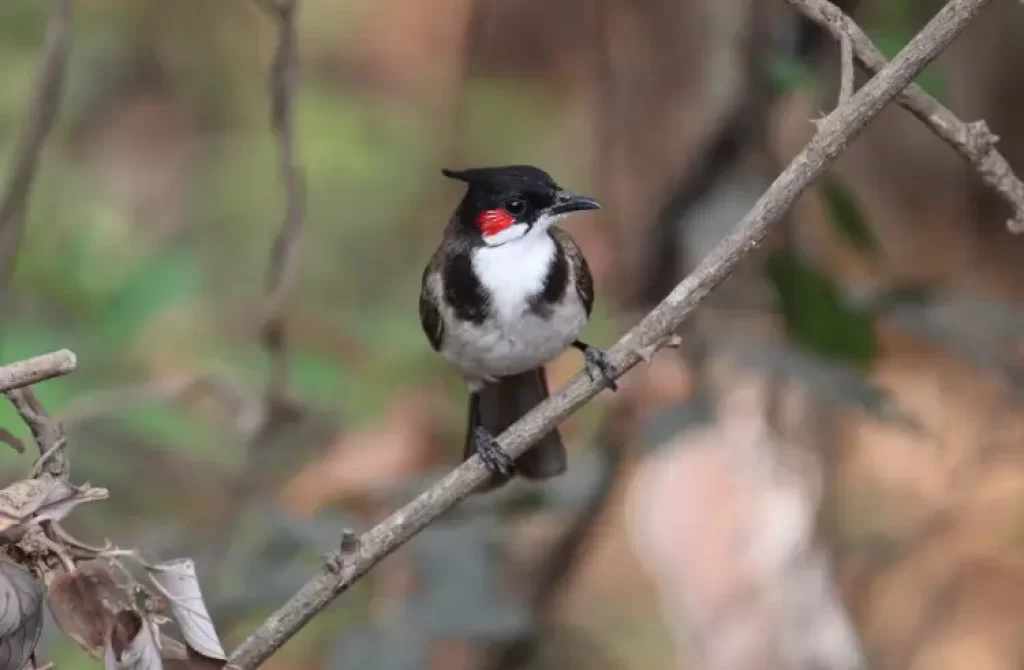
The Red-whiskered Bulbul (Pycnonotus jocosus) graces the landscapes of South Asia with its striking presence.
One cannot help but be captivated by the distinctive red patches adorning this bird’s face, just behind its eyes. This avian resident of the region adds a vibrant touch to the lush surroundings, making it a familiar and cherished sight among bird enthusiasts.
With its melodious calls and engaging behavior, the Red-whiskered Bulbul has earned its place as a beloved member of South Asia’s avian community.
14. Red-capped Robin (Heteromyias armiti)
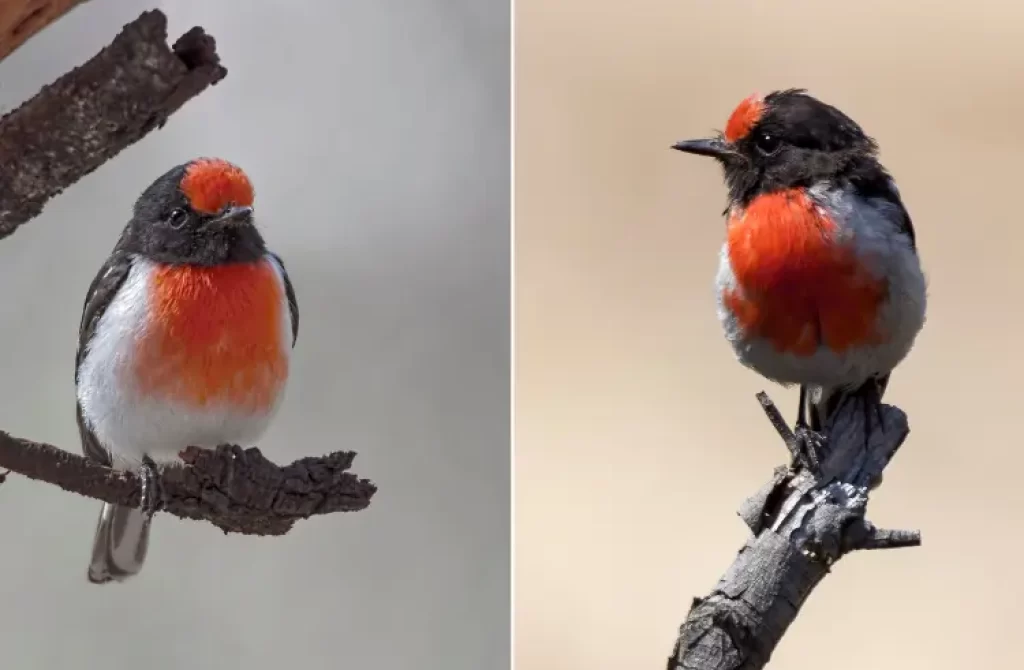
The Red-capped Robin (Heteromyias armiti) is a distinctive Australian robin that commands attention with its striking appearance. This small songbird, measuring around 11 to 13 centimeters (4.3 to 5.1 inches) in length, boasts a vibrant crimson cap atop its head, which contrasts beautifully with the rest of its plumage.
Its back, wings, and tail feathers are colored in various shades of gray, creating an elegant balance with its bold red crown.
This robin is a common resident of the eucalyptus forests that dot Australia’s landscape. It prefers habitats with open woodlands, where it can forage for insects and small invertebrates among the trees and shrubs.
Birdwatchers and nature enthusiasts often seek out the Red-capped Robin for its captivating appearance and lively presence in the Australian wilderness.
15. Vermilion Flycatcher (Pyrocephalus obscurus)
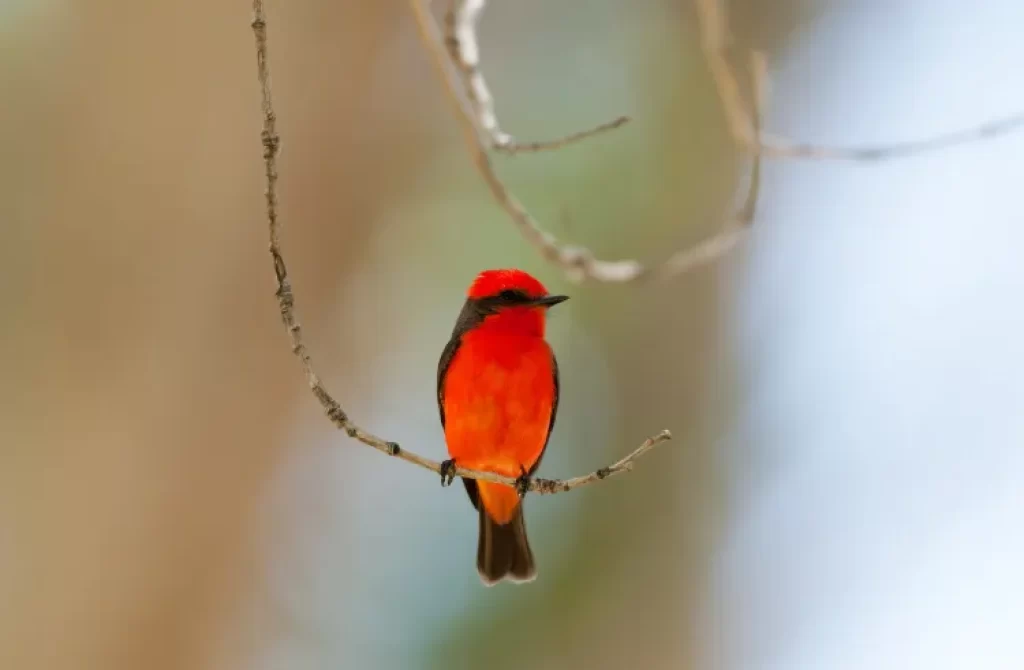
The Vermilion Flycatcher (Pyrocephalus obscurus) is a captivating bird native to the Americas, celebrated for its vibrant red plumage, particularly among males.
This striking species stands out with its fiery red feathers, creating a vivid contrast against its surroundings. The males, in particular, wear this brilliant red plumage as a badge of their identity.
With a size of about 15 centimeters (6 inches) in length, the Vermilion Flycatcher is a relatively small bird, but its vivid appearance makes it a sought-after sight for birdwatchers and wildlife enthusiasts.
These birds are skilled flycatchers, capturing insects mid-air with precision. Their presence adds a touch of fiery beauty to the diverse avian population of the Americas.
16. Red-crowned Crane (Grus japonensis)
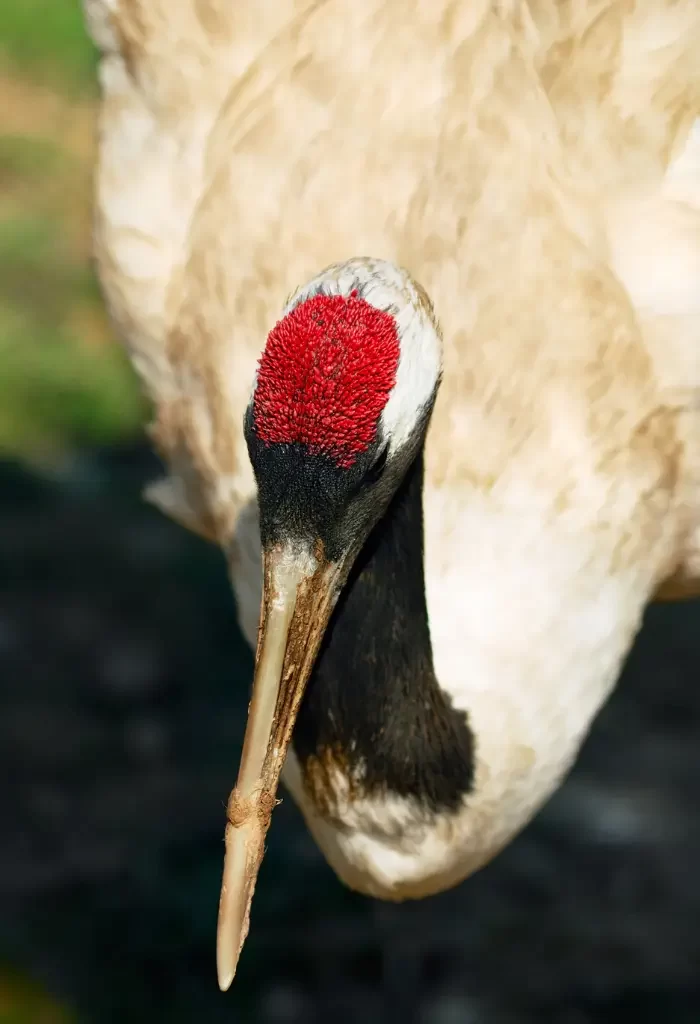
The majestic Red-crowned Crane, known as the symbol of longevity and good fortune in Japan, is a captivating bird that stands out with its vibrant red crown. Revered for its elegance and grace, this crane species inhabits eastern Asia, including Japan, China, and parts of Russia.
The striking red crown atop the Red-crowned Crane’s head is a distinguishing feature, adding to its cultural significance.
These cranes are often seen in wetlands, marshes, and grasslands, where they engage in intricate courtship dances and soaring flights that symbolize their bond and devotion as a monogamous species.
As an integral part of Japanese folklore and culture, the Red-crowned Crane holds a special place in the hearts of people across the region.
Efforts to protect and conserve their habitats are ongoing, ensuring that these magnificent birds continue to inspire generations to come.
17. Barn Swallow (Hirundo rustica)
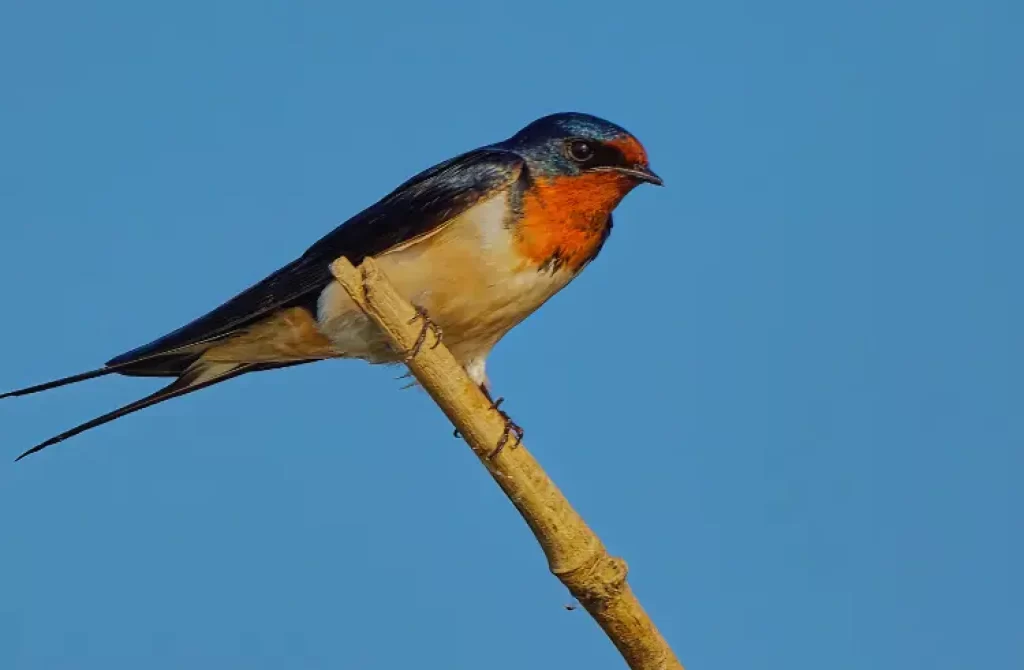
The Barn Swallow (Hirundo rustica) is a captivating bird known for its graceful flight and distinctive appearance. As a widely distributed species, it can be found on nearly every continent, making it a familiar sight to many bird enthusiasts.
Barn Swallows are recognized by their striking features, including long, pointed wings, deeply forked tails, and vibrant coloring. They exhibit a cobalt-blue back and wings, with a cinnamon-colored throat and underparts. Their distinctive tail shape, with two elongated streamers, sets them apart.
These agile birds are commonly associated with human-made structures like barns, hence their name. They are often found in open habitats, including farmlands, meadows, and wetlands. While they breed in North America, Europe, and Asia, they migrate to South America and Africa during the winter months.
Barn Swallows are renowned for their aerial prowess. They are skilled in capturing insects mid-flight and are often seen swooping and darting through the air in pursuit of their prey. Their acrobatic flight patterns are a delight to witness.

These swallows build cup-shaped nests, often using mud pellets. They attach these nests to vertical surfaces like the rafters of barns or the eaves of buildings. It’s common to find these nests in colonies, providing an opportunity to observe their social interactions.
Barn Swallows are known for their lengthy migrations. They undertake impressive journeys, covering thousands of miles between their breeding and wintering grounds. Their migrations are a testament to their endurance and navigational skills.
Fun fact: 🌍 World-Travelers: These swallows are exceptional long-distance flyers. They migrate between their breeding grounds in North America and their wintering grounds in Central and South America, covering thousands of miles each way.
While not currently considered endangered, some populations of Barn Swallows face threats due to habitat loss and changes in insect populations, which serve as their primary food source.
Spotting a Barn Swallow in its natural habitat or observing its intricate nests can be a rewarding experience for bird enthusiasts. These aerial acrobats continue to inspire admiration for their remarkable flight and adaptability.
You might also like: Exploring the Beauty and Behaviors of Partridges
18. Red-headed Finch (Amadina erythrocephala)
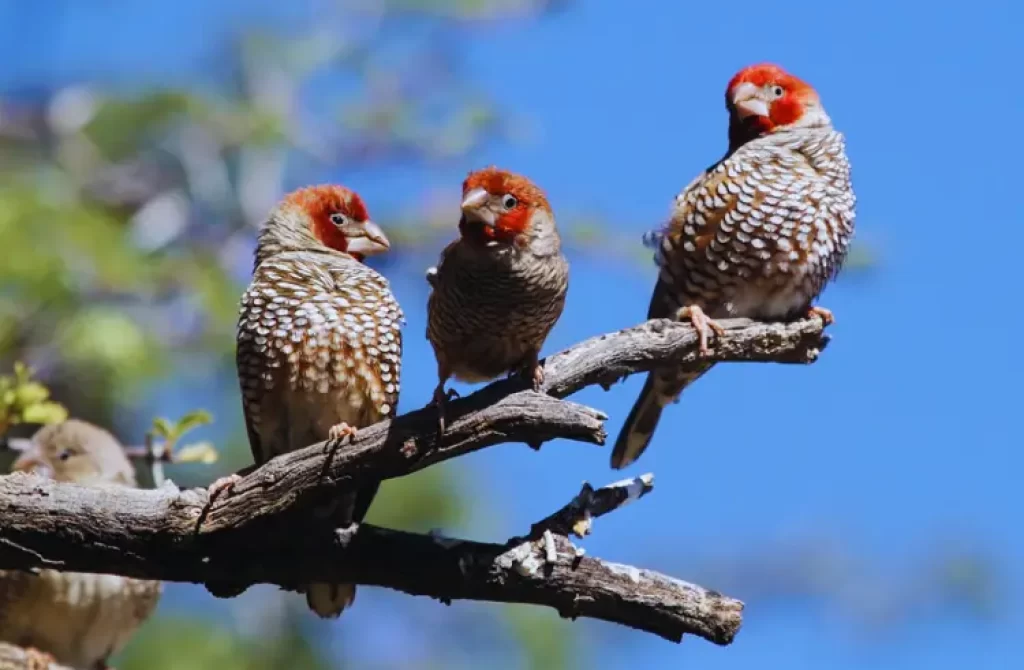
The Red-headed Finch (Amadina erythrocephala), a native of Africa, is a finch species that captivates with its stunning red head, which stands out against the backdrop of the savannas.
These sociable birds are often spotted in the grassy expanses of their African habitat, where their bright red crowns catch the eye of fortunate observers. Their presence adds a touch of vibrancy to the sweeping landscapes they call home.
If you’re keen to witness the Red-headed Finch in the wild, exploring the savannas and grasslands of Africa during the right season can provide a memorable encounter with these charming feathered creatures.
19. Red-crowned Parrot (Amazona viridigenalis)
The Red-crowned Parrot (Amazona viridigenalis), sporting its distinctive red crown, is a charismatic and vibrant inhabitant of Central America.
These enchanting parrots, with their bright red head feathers, are commonly seen and celebrated in the lush landscapes of Central America.
Whether perched in the canopy of tropical forests or exploring urban neighborhoods, they bring a burst of color and lively chatter to their surroundings.
For those with a passion for avian encounters, a journey to Central America offers an excellent opportunity to observe and appreciate the Red-crowned Parrot in its natural habitat, adding a splash of vibrancy to any birdwatching expedition.
20. Red-capped Cardinal (Paroaria gularis)
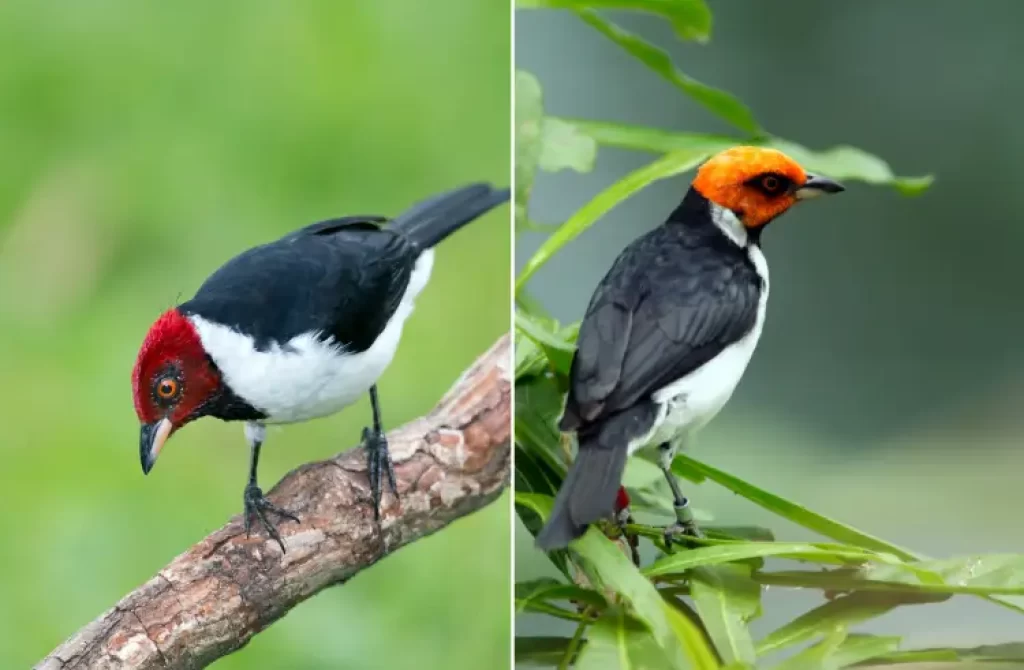
The Red-capped Cardinal (Paroaria gularis), native to South America, stands out with its fiery red cap atop its head.
These striking cardinals are a captivating sight in the vibrant landscapes of South America. With their bright red head and contrasting plumage, they add a touch of fiery elegance to the lush habitats they call home.
For bird enthusiasts and nature lovers, exploring the rich biodiversity of South America can offer a chance to witness the Red-capped Cardinal in all its colorful glory.
Their presence adds a burst of warmth to the already stunning natural tapestry of the continent, making them a prized find for birdwatchers.
21. Red-vented Cockatoo (Cacatua haematuropygia):
The Red-vented Cockatoo (Cacatua haematuropygia), known for its snowy plumage adorned with vibrant red undertail coverts, captivates bird enthusiasts with its exotic beauty.
Native to the verdant landscapes of Southeast Asia, this cockatoo species provides a mesmerizing contrast of colors. Its pristine white feathers are accentuated by the vivid red plumage underneath, creating a stunning spectacle in the wild.
To catch a glimpse of the Red-vented Cockatoo in its natural habitat, one must embark on an adventure to the lush rainforests and tropical woodlands of Southeast Asia. Among the emerald canopies and vibrant flora, these charming cockatoos add a touch of color and elegance to the rich tapestry of the region’s wildlife.
22. Red-naped Ibis (Pseudibis papillosa)
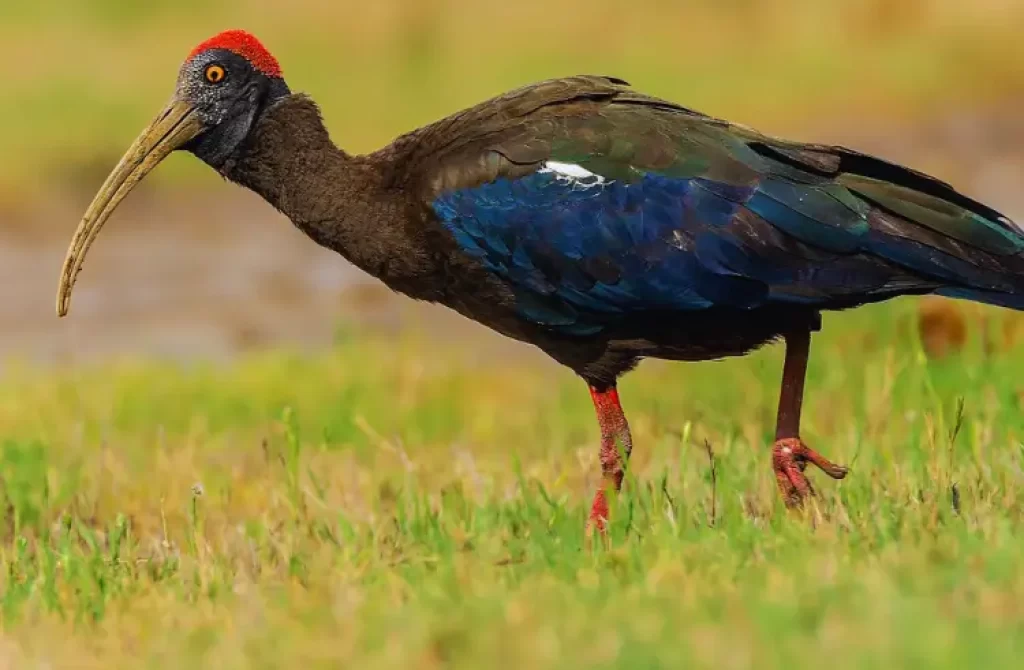
The Red-naped Ibis (Pseudibis papillosa) is a captivating avian species native to the enchanting landscapes of South Asia. Distinguished by its striking red head and neck, this bird stands out as a vibrant gem amidst the lush surroundings.
Measuring up to 75 centimeters in length, the Red-naped Ibis showcases a stately presence with its elegant crimson plumage. Its robust build and prominent red coloring make it a remarkable sight for birdwatchers and nature enthusiasts.
To witness the beauty of the Red-naped Ibis in its natural habitat, one should explore the wetlands, marshes, and riverbanks of South Asia. Here, amidst the tranquil waters and abundant vegetation, these majestic birds add a touch of brilliance to the region’s diverse avian population.
23. Red-faced Cormorant (Phalacrocorax urile)
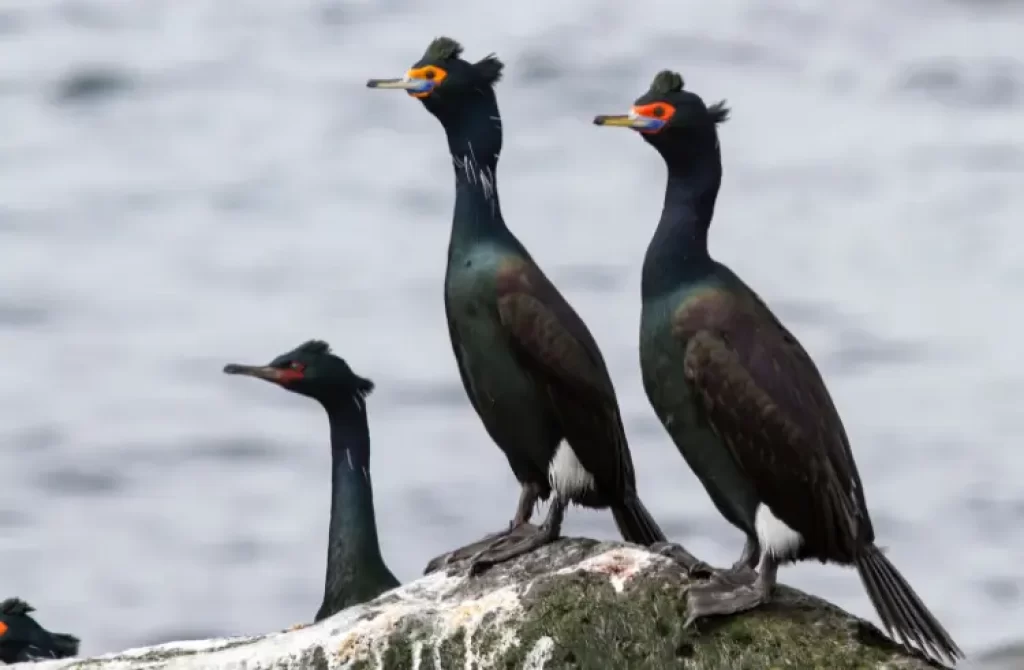
The Red-faced Cormorant (Phalacrocorax urile) is a captivating avian species that graces the North Pacific coastlines during the breeding season. As its name suggests, this cormorant exhibits a striking red face, making it a distinctive and memorable sight for bird enthusiasts.
Measuring approximately 70 centimeters in length, the Red-faced Cormorant possesses a sleek and elegant appearance. Its characteristic red facial markings become particularly pronounced during the breeding season, adding to its allure.
To observe these remarkable birds in their natural habitat, one should venture to the North Pacific coastlines. Here, against the backdrop of rugged coastlines and pristine waters, the Red-faced Cormorant’s striking red face becomes a testament to the beauty of nature’s creations.
24. Red-crowned Woodpecker (Melanerpes rubricapillus)
The Red-crowned Woodpecker (Melanerpes rubricapillus) is a captivating avian resident of Central America. What sets this woodpecker apart is its distinctive red crown, which adds a vibrant burst of color to the lush forests it calls home.
Measuring approximately 20 centimeters in length, this woodpecker boasts a compact yet charming physique. Its red crown serves as a striking feature against its black and white plumage, making it easily recognizable to birdwatchers and nature enthusiasts.
To witness the beauty of the Red-crowned Woodpecker in person, one must explore the diverse ecosystems of Central America.
Amidst the dense foliage and towering trees, this woodpecker’s fiery crown is a testament to the splendor of the natural world.
25. Red-winged Tinamou (Rhynchotus rufescens):
The Red-winged Tinamou (Rhynchotus rufescens) is a captivating bird native to the diverse landscapes of South America. What distinguishes this tinamou is the vibrant red patch adorning its wings, adding a splash of color to its predominantly brown plumage.
Measuring around 40 to 45 centimeters in length, the Red-winged Tinamou possesses a moderately sized physique that allows it to navigate the various habitats it calls home. The striking red patch on its wings stands out prominently against the earthy tones, making it an alluring sight for birdwatchers and nature enthusiasts.
To observe the Red-winged Tinamou in its natural habitat, one must venture into the rich and varied environments of South America, where this tinamou’s red wings are a testament to the beauty of the continent’s avian diversity.
26. Crimson Rosella (Platycercus elegans)
The Crimson Rosella (Platycercus elegans) is a charming Australian parrot renowned for its vivid crimson head and vibrant plumage. This avian gem is a beloved sight for bird enthusiasts and a testament to Australia’s rich biodiversity.
Measuring approximately 36 centimeters in length, the Crimson Rosella sports a compact yet striking appearance.
Its bright crimson head and contrasting blue cheeks and wings create a stunning visual contrast, making it a captivating presence in the eucalyptus forests and woodlands of its native Australia.
To catch a glimpse of the Crimson Rosella in the wild, one must explore the lush landscapes of Australia, where this avian beauty thrives.
Whether you’re an avid birdwatcher or simply appreciate the wonders of nature, encountering the Crimson Rosella is a memorable experience.
27. Red-headed Finch (Amandava amandava)
The Red-headed Finch (Amandava amandava) is a petite yet captivating finch species native to the diverse landscapes of South Asia. Its name is a direct reflection of its most distinctive feature: a vivid red head that instantly sets it apart in the avian world.
Measuring around 10 centimeters in length, the Red-headed Finch may be small in stature, but its striking appearance more than makes up for its size. With its fiery red crown and nape, it’s a true standout against the lush greenery of its habitat.
In the wild, you can find the Red-headed Finch gracing the savannas, grasslands, and open woodlands of South Asia. Its presence adds a touch of vibrant color to these landscapes, making it a favorite among birdwatchers and nature enthusiasts.
Witnessing this charming finch in its natural habitat is a delightful experience for anyone exploring the region’s rich biodiversity.
28. Red-shouldered Vanga (Calicalicus rufocarpalis):
The Red-shouldered Vanga (Calicalicus rufocarpalis) is an avian gem that hails from the unique island of Madagascar. Its name succinctly describes its defining feature—a striking red-shouldered appearance that sets it apart in the world of vangas.
Endemic to Madagascar, this bird is known for its vibrant red plumage on its shoulders, adding a splash of color to the lush and diverse landscapes of the island.
With its distinctive red markings and elegant form, the Red-shouldered Vanga is a sought-after sight for bird enthusiasts and wildlife lovers exploring the captivating biodiversity of Madagascar.
These charming birds primarily inhabit Madagascar’s forests, where their striking appearance complements the rich tapestry of flora and fauna that make the island a biological treasure trove.
Observing a Red-shouldered Vanga in its native habitat is a remarkable experience that highlights the extraordinary natural heritage of Madagascar.
29. Red-billed Quelea (Quelea quelea)
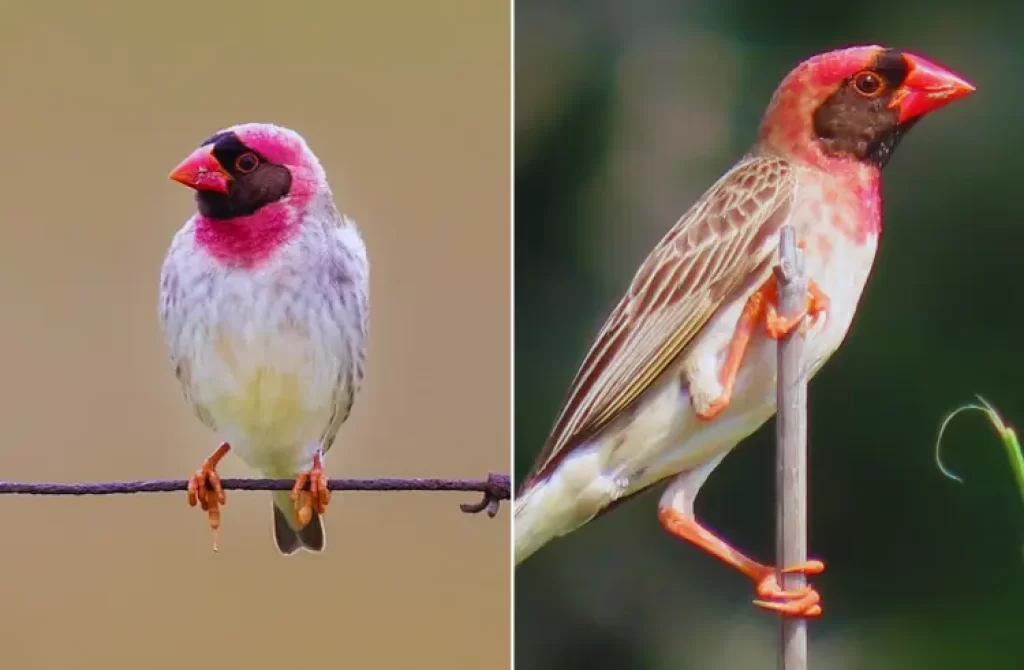
The Red-billed Quelea (Quelea quelea) is a bird native to Africa, known for its distinctive red bill. This small passerine bird, often found in large flocks, is recognized by its striking crimson bill, which stands out prominently against its otherwise subdued plumage.
Red-billed Queleas are highly social birds and are often seen in vast numbers, making their presence impossible to ignore, especially during the breeding season when they congregate to nest. They inhabit a range of habitats across Africa, from grasslands and savannas to wetlands and agricultural fields.
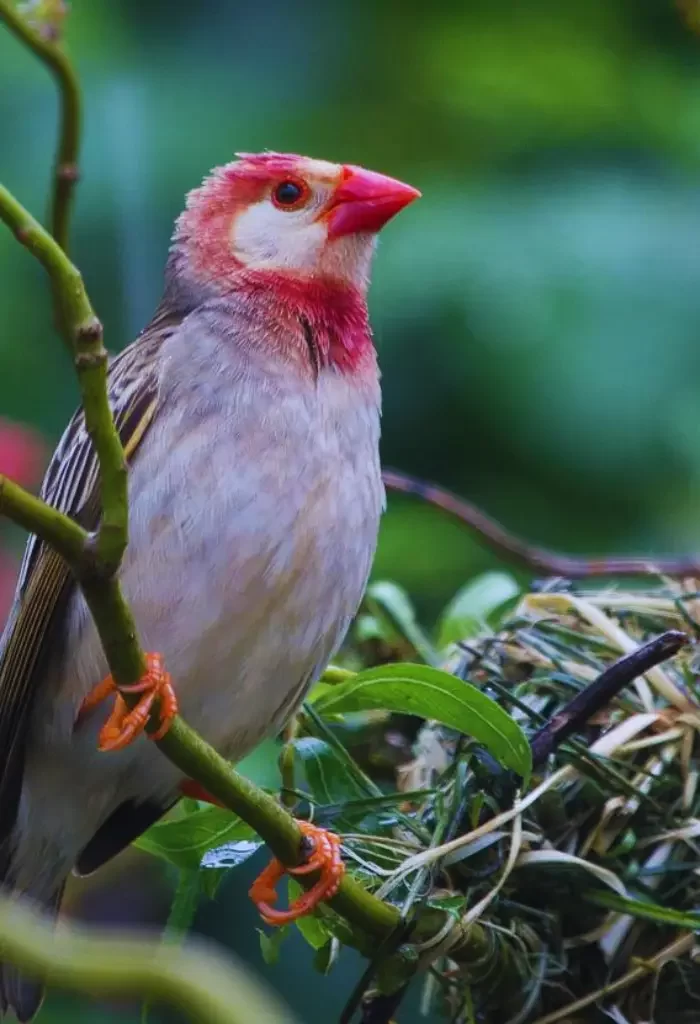
Despite their small size and unassuming appearance, Red-billed Queleas are fascinating birds with unique behaviors and ecological importance.
Their red bills are a distinguishing feature that draws the attention of bird enthusiasts and ornithologists studying the avian diversity of Africa’s landscapes.
30. Red Junglefowl (Gallus gallus)
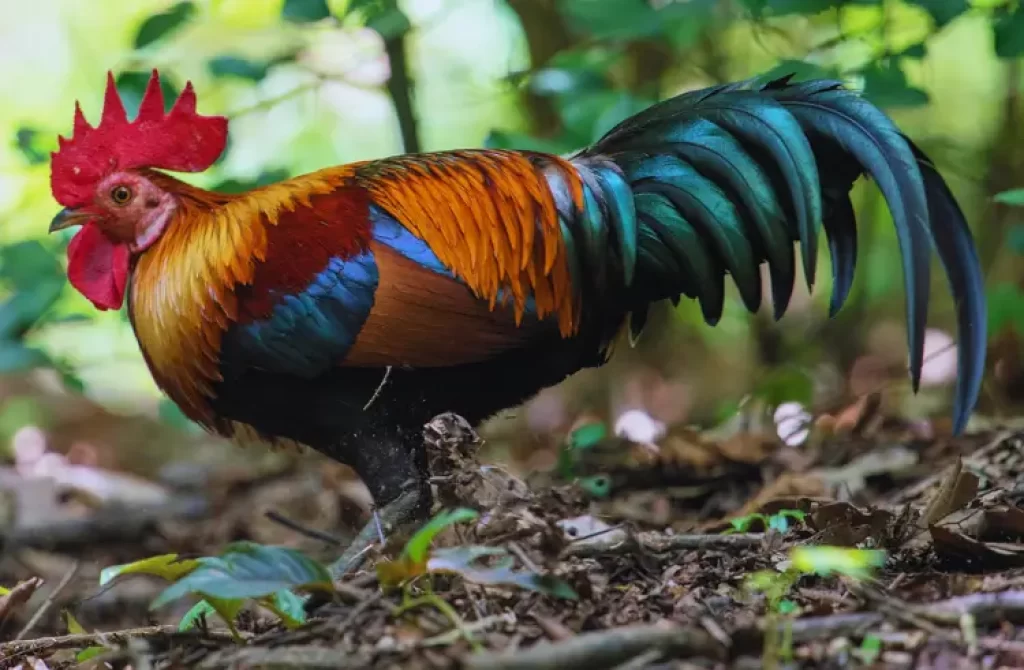
When it comes to birds with red heads, few are as captivating as the Red Junglefowl (Gallus gallus). These remarkable birds, found in Southeast Asia’s lush forests, are known for their striking appearance and historical significance.
he Red Junglefowl’s males, or roosters, are a sight to behold. They flaunt vibrant crimson combs, wattles, and facial skin, beautifully contrasting with their emerald-green tail feathers. Measuring approximately 26 inches (66 cm) in length, they’re a medium-sized species.
To spot these birds in the wild, explore the dense tropical and subtropical forests of countries like India, Indonesia, Thailand, and Malaysia. Often found near rivers and streams, they forage on seeds, fruits, insects, and small invertebrates. Their distinctive crowing serves to establish territory and attract mates, making them a vocal presence in the forest.
Notably, the Red Junglefowl is the primary ancestor of domesticated chickens. Millennia of selective breeding have given rise to diverse chicken breeds worldwide, all tracing their lineage back to these wild ancestors.
Next time you’re in Southeast Asia’s enchanting forests, keep an eye out for the Red Junglefowl, a living testament to the captivating world of birds with red heads and their intriguing evolutionary journey.
31. Red-headed Lovebird (Agapornis pullarius)
The Red-headed Lovebird (Agapornis pullarius) is a captivating parrot native to Africa, distinguished by its endearing red face. These charming birds are celebrated not only for their striking appearance but also for their affectionate and sociable nature.
In their natural habitat of African savannas and woodlands, Red-headed Lovebirds are often spotted in pairs or small flocks, showcasing their strong bond with their mates. Their bright red heads and vibrant plumage add a burst of color to the African landscape, making them a favorite among birdwatchers and avian enthusiasts.
Fun fact: 🧺 Foraging Techniques: Red-headed Lovebirds are skilled foragers. They use their strong beaks to crack open seeds and nuts. They are also known to feed on fruits and berries, making them important dispersers of seeds in their habitats.
Observing Red-headed Lovebirds in the wild provides an opportunity to witness their loving interactions and their important role in their ecosystem. These lovebirds serve as both pollinators and seed dispersers, contributing to the biodiversity of their African habitats.
32. Anna’s Hummingbird (Calypte anna)
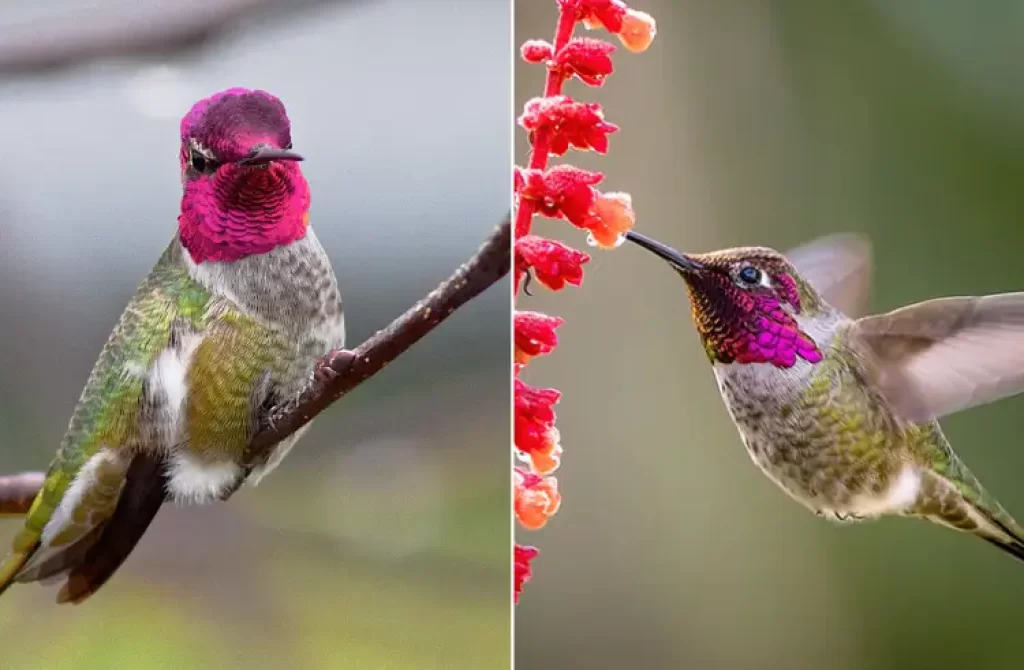
Anna’s Hummingbird (Calypte anna) is a striking and resilient bird species native to the western coast of North America. Known for its vibrant plumage, dazzling aerial displays, and adaptability to urban environments, it’s a beloved symbol of the region’s biodiversity.
These diminutive birds exhibit sexually dimorphic plumage. Males boast iridescent pinkish-red throats and crowns, which shimmer in the sunlight. Females have a subtler greenish-gray plumage with some red spotting on their throats.
Anna’s Hummingbirds are year-round residents along the western coast of North America, from Alaska to Baja California. They are adaptable and can thrive in a variety of habitats, from coastal areas to urban gardens.
Anna’s Hummingbirds are known for their impressive aerial displays. Males perform high-speed courtship dives, creating a distinctive chirping sound as they dive. These displays are a part of their intricate mating rituals.
Their diet primarily consists of nectar from flowers, which they obtain by rapidly flapping their wings and hovering in front of blossoms. They also feed on insects and spiders for protein.
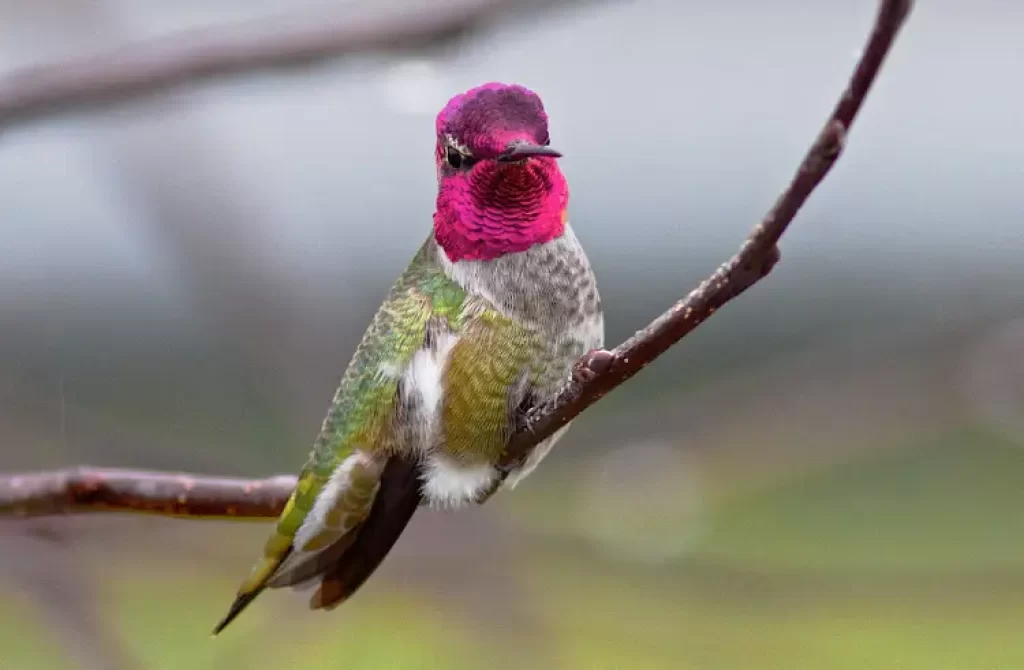
Anna’s Hummingbirds construct compact, cup-shaped nests made of plant material and spider silk, often in trees, shrubs, or even hanging planters. They are known for their brood parasitism behavior, occasionally laying eggs in the nests of other hummingbirds.
Anna’s Hummingbirds are not currently considered threatened or endangered. In fact, their adaptability to urban environments has allowed them to thrive in many cities along the West Coast.
Spotting an Anna’s Hummingbird in flight, with its iridescent plumage and dazzling aerial displays, is a testament to the remarkable diversity of life along the western coast of North America.
Conclusion
Birds with red heads represent a captivating and diverse group, adorning different corners of the world with their vibrant plumage. They inject a burst of color into their respective habitats, enchanting bird enthusiasts and nature lovers alike.
Whether you find yourself wandering through the woodlands of North America, the rainforests of South America, or the savannas of Africa, these avian gems with fiery crowns serve as a compelling testament to the sheer wonder of our planet’s avian diversity.
If you’re eager to explore more about these captivating creatures and other fascinating animals, delve into our articles below; we’re confident you’ll be enthralled by the wealth of knowledge they offer.
Up next:
Kenno Marques is a self-taught English speaker deeply passionate about nature and wildlife. He dedicates his time to scouring the web for the latest animal news and engaging content, which he shares on various websites. Fluent in three languages, Kenno is currently on a journey to master German. His commitment to fostering an understanding of the natural world makes him a valuable contributor to the online community.





